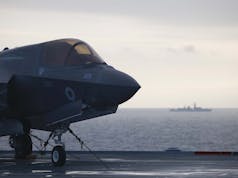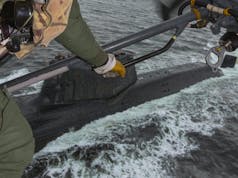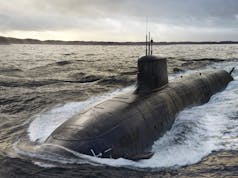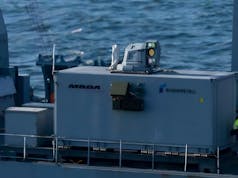Submarines from the U.S. and Portuguese navies have conducted joint anti-submarine warfare (ASW) training and operational experimentation during NATO’s Dynamic Messenger/REPMUS 2025 exercises off Portugal.
The Virginia-class fast-attack submarine USS New Mexico (SSN 779) and Portuguese diesel-electric NRP Tridente (209PN) trained alongside the frigate NRP Francisco de Almeida (F334) and patrol vessel NRP Setubal (P363).
A highlight of the exercise was USS New Mexico’s deployment of a submarine-launched unmanned aerial system (UAS) in what NATO described as operational experimentation.
Rear Admiral Grabbe, Commander of NATO Submarines, said: “This training and the operational experimentation embody innovation and demonstrate how Allies can integrate submarines with unmanned platforms to achieve operational advantage.” He added that such cooperation “paves the way for future operations where traditional and emerging technologies must operate seamlessly in high-threat, multi-domain theatres.”
Vice Admiral Robert Gaucher, Commander Submarine Force / Allied Submarine Command, linked the trials directly to protecting critical infrastructure. “Our commitment to Dynamic Messenger/REPMUS highlights the shared imperative for the U.S. and all our NATO partners to defend the seabed. By demonstrating interoperability between our platforms, people, and robotic autonomous systems, we build the capability and capacity to share the burden of defending our critical undersea infrastructure.”
Running in tandem, the Portuguese-led Robotic Experimentation and Prototyping with Maritime Unmanned Systems (REPMUS) exercise focused on maritime unmanned systems development and interoperability.
Vice Admiral José Salvado de Figueiredo, Fleet Commander of the Portuguese Navy, said:
“Having the Portuguese submarine NRP Tridente operating with USS New Mexico, participating in the largest NATO/Portugal maritime robotics exercise in the world, Dynamic Messenger/REPMUS, and conducting operational experimentation with unmanned systems, constitutes a relevant milestone in the already long history of the Portuguese Navy Submarine Service.”
Both exercises, NATO said, aim to deliver unmanned systems and capabilities into Allied naval forces with speed and scale.














Have I understood this right? Seems odd that a submarine doing ASW exercises would deploy an aerial drone. You’d have thought it would try to remain hidden from surface ships. Surely it wouldn’t surface to launch/communicate with its drone, would it? Meanwhile we are still having issues getting our frigate launched ASW-hunting drones working.
I suppose if it was an autonomous one way drone with an explosive warhead it could do nasty things to any rotor based assets in the ASW screen, especially drone based ASW assests..
Frigate launches ASW drones to hunt SSN..SSN launches drone hunting drone to knock down ASW drones…
I think we still require a person in the loop. An aerial loitering mine would be classed as unethical (until hit by the reality of war).
They wait untill it’s dark outside.
This is interesting, the PLAN now has an autonomous drone ship that launches airborne drone and possibly sub surface drones. We have SSN launched drones.
You can see what the possibilities are for naval warfare are in a decade or so..because Ukraine has given us the early answers..
Specifically the littoral and enclosed seas is going to be utterly dominated by drone based combat, probably with drones essentially fighting drones as they try and dominate the ISTAR environment and locate the manned mother vessels and high value assests.
I think the deep oceans may be a bit different, after all a carrier battle group with plenty of sea space can be travelling around at 20knt.same with transiting SSNs on their way to deliver cruised missiles into a target. that pure speed, space and distance would likely frustrate present and near future drones.. which need to exchange speed for endurance and endurance and speed for payload.
So I can see two separate battles, the strategic platforms still focus manned assets.. but massive numbers of drone based assets for littoral work… places like the Baltic, china seas, gulf and the key shipping choke points etc are likely to be totally dominated by drone warfare.. EEZ infrastructure monitoring and attack drone warfare based.. but strategic attack and defence and the high seas will still be the domains of the high end crewed platforms.
No idea what relevance this has operationally, but worth noting that German submarines were much slower than surface ships certainly submerged yet manage to very nearly win the battle of the Atlantic so there are ways around being physically slower than your prey, especially with modern technology and given improving capabilities. Underwater drones can already have a 1000km operating radius and 45 day endurance submerged. Still feel communication issues are the key for all longer range autonomous platforms, even those exploiting high level ai autonomy.
I believe the U boats had the about the same strategic mobility as the convoys they hunted and greater tactical speed. Remembering they manoeuvred to engage on the surface until 1943 after 1943 they tended to only manoeuvre on the surface with caution or at night due to airborne ASW… this was what essentially tipped it over as the aircover reduced their mobility to below that of the convoys they hunted.
So your average u boat had a cruise speed of around 10-11 knots , it had a top speed of 15-20 knots for tactical manovering and a sub surface speed of 4-8 knots
Convoys tended to be split into slow 8:knots or below, medium 9-10 knots or fast 13knots…
WW2 merchant ships were seriously slow plodders and surfaced U boats not so much.
Officially never disclosed but our Victor bombers had suspected underwater capabilities I like to think.
Well the Vulcan certainly did I saw it in Thundeball.